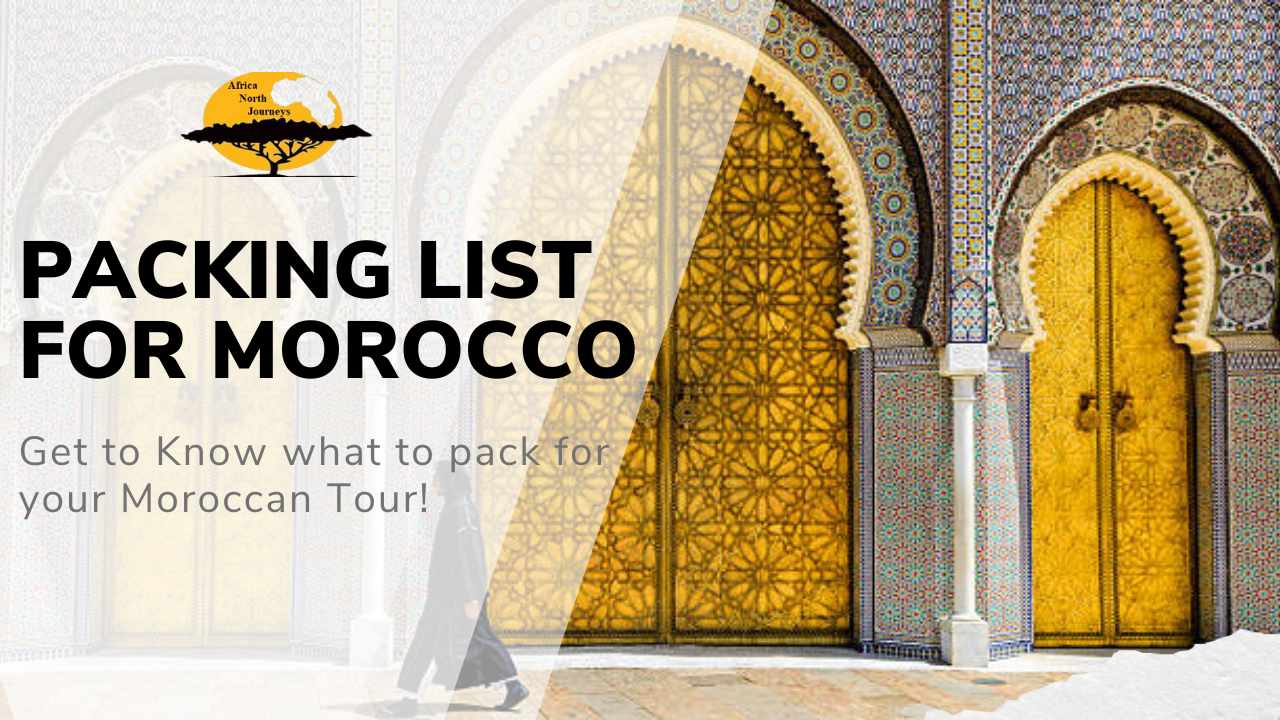Clothing
1. Lightweight Layers
Morocco’s climate varies significantly between regions and seasons. Lightweight, breathable layers are essential for adjusting to temperature changes throughout the day.
- T-shirts and tank tops: Opt for breathable fabrics like cotton or linen.
- Long-sleeve shirts: Protects against the sun and cool evening breezes.
- Sweater or light jacket: Necessary for cooler mornings and evenings, especially in the mountains or desert.
- Lightweight scarf or shawl: Useful for covering your head in religious sites and protecting against the sun.
2. Modest Attire
Morocco is a predominantly Muslim country with conservative dress norms, especially in rural areas. Dressing modestly shows respect for local customs and helps you blend in.
- Long skirts or pants: Women should bring skirts or dresses that cover the knees. Men should avoid shorts in conservative areas.
- Long-sleeve shirts or blouses: Helps cover your shoulders and arms.
- Loose, comfortable clothing: Helps keep you cool and shows respect for local culture.
3. Footwear
Comfortable and versatile footwear is essential for exploring Morocco’s diverse landscapes.
- Comfortable walking shoes or sandals: Essential for navigating cobblestone streets and medinas.
- Hiking boots: If you plan to trek in the Atlas Mountains or the desert.
- Flip-flops or shower shoes: Useful for communal bathrooms in hostels or riads.
4. Specialty Clothing
Depending on your planned activities, you might need specific gear.
- Swimsuit: For hotel pools, beaches, or hammams (traditional Moroccan baths).
- Thermal underwear: Essential if visiting the mountains in winter.
- Rain jacket: Particularly useful during the rainy season (November to March).
Accessories
1. Sun Protection
Morocco can be very sunny, so protecting yourself from the sun is crucial.
- Wide-brimmed hat or cap: Essential for sun protection.
- Sunglasses: Protect your eyes from the harsh sun.
- Sunscreen: High SPF to protect your skin from UV rays.
2. Travel Essentials
These items can make your trip more comfortable and convenient.
- Travel adapter: Morocco uses type C and E outlets, and the voltage is 220V.
- Portable phone charger: Keep your devices charged while on the go.
- Reusable water bottle: Staying hydrated is essential, and it’s environmentally friendly.
- Daypack or small backpack: For carrying daily essentials and exploring.
- Money belt or hidden pouch: For keeping your valuables safe.
3. Personal Care
Don’t forget these essential toiletries and personal care items.
- Toothbrush and toothpaste
- Deodorant
- Shampoo and conditioner
- Soap or body wash
- Razor and shaving cream
- Feminine hygiene products
- Hairbrush or comb
- Nail clippers
- Hand sanitizer
- Wet wipes
Travel Documents and Money
1. Essential Documents
Having all your necessary documents organized and accessible is crucial.
- Passport: Ensure it’s valid for at least six months beyond your travel dates.
- Visas: Check if you need a visa and arrange it in advance if necessary.
- Travel insurance: Includes health and trip coverage.
- Printed copies of important documents: Passport, visa, travel insurance, flight and accommodation details, and emergency contacts.
2. Money Management
Managing your finances efficiently can save you time and stress.
- Credit and debit cards: Inform your bank of your travel plans to avoid card blocks.
- Cash: Both Moroccan dirhams (MAD) and a small amount of US dollars or euros for emergencies.
- Money belt or hidden pouch: To keep your cash and cards secure.
Technology
1. Communication and Navigation
Stay connected and find your way with these gadgets.
- Smartphone: For communication, maps, and travel apps.
- Power bank: Keeps your devices charged during long days out.
- Camera: To capture the incredible sights, though a smartphone camera might suffice.
- Chargers and cables: For all your devices.
2. Entertainment
Keep entertained during downtime or long journeys.
- E-reader or book: For reading during travel or relaxation.
- Headphones or earbuds: For listening to music, podcasts, or audiobooks.
- Travel journal: To document your experiences and memories.
Health and Safety
1. First Aid Kit
A basic first aid kit can be a lifesaver for minor injuries or ailments.
- Prescription medications: Ensure you have enough for your entire trip.
- Pain relievers: Such as ibuprofen or acetaminophen.
- Antihistamines: For allergies or insect bites.
- Band-aids and blister plasters: For minor cuts and blisters.
- Antiseptic wipes or cream: To clean and protect wounds.
- Motion sickness tablets: If you’re prone to travel sickness.
- Rehydration salts: Useful for heat exhaustion or stomach issues.
2. Health Precautions
Staying healthy is essential to enjoying your trip.
- Water purification tablets or filter: If you plan to hike or visit remote areas.
- Mosquito repellent: Especially important if you’re visiting during warmer months.
- Travel-size hand sanitizer: To keep your hands clean on the go.
Optional Items
Depending on your personal preferences and specific travel plans, you might consider bringing these additional items.
1. Adventure Gear
For those planning outdoor activities or excursions.
- Sleeping bag liner: For extra comfort and hygiene in hostels or desert camps.
- Dry bag: To keep your belongings dry during water activities or rainy weather.
- Binoculars: Useful for birdwatching or exploring nature reserves.
2. Cultural and Religious Sites
If you plan to visit many cultural or religious sites.
- Modest clothing: Extra pieces to ensure you’re appropriately dressed for all visits.
- Headscarf: For women, useful in mosques or conservative areas.
3. Gifts and Souvenirs
Bring small gifts or items from home as tokens of appreciation for local hospitality.
- Postcards or trinkets from your home country: Small tokens to share with locals or hosts.
- Reusable shopping bag: Handy for carrying purchases or groceries.
Packing Tips
1. Pack Light and Smart
Opt for versatile and multi-purpose items to keep your luggage light.
- Mix and match clothing: Choose neutral colors that you can easily combine.
- Compression bags: Save space and keep your belongings organized.
- Roll your clothes: Rolling instead of folding can save space and reduce wrinkles.
2. Leave Room for Souvenirs
Morocco is known for its beautiful handicrafts and textiles. Leave some space in your luggage for any treasures you might want to bring home.
- Extra bag or foldable duffel: For carrying souvenirs or gifts on your return trip.
- Protective wrapping: Bubble wrap or cloth to protect fragile items.
3. Be Prepared for Different Climates
Morocco’s climate varies widely, so pack for different weather conditions.
- Layering: Helps you adapt to changing temperatures, from hot days to cool nights.
- Waterproof items: A light rain jacket or umbrella for unexpected showers.
Destination-Specific Considerations
Depending on where you plan to go in Morocco, you might need to adjust your packing list.
1. Cities and Medinas
If you’re visiting bustling cities like Marrakech, Fes, or Casablanca:
- Comfortable walking shoes: Essential for navigating uneven streets and busy markets.
- Earplugs: City noise can be overwhelming, especially if you’re staying near busy areas.
- Small backpack or daypack: For carrying daily essentials and keeping your hands free.
2. Atlas Mountains
For trekking and exploring the Atlas Mountains:
- Hiking boots: Sturdy and comfortable for rough terrain.
- Thermal layers: Necessary for high altitudes, especially in winter.
- Snacks and energy bars: Useful for long hikes.
3. Sahara Desert
If you’re planning a desert adventure:
- Headscarf or bandana: To protect against sand and sun.
- Lightweight, long-sleeve shirts and pants: To cover up from the sun and sand.
- Camel-friendly footwear: Comfortable and secure for camel rides.
4. Coastal Areas
For visiting coastal towns like Essaouira or Agadir:
- Swimsuit: For enjoying the beaches or hotel pools.
- Beach towel or sarong: Lightweight and quick-drying options.
- Flip-flops or sandals: Easy to slip on and off for beach days.
Conclusion of Packing List for Morocco
Packing for Morocco requires a bit of planning and consideration, but with the right preparation, you’ll be well-equipped to handle any adventure that comes your way. From the bustling medinas and historic cities to the serene mountains and expansive deserts, this packing list ensures you’re ready to explore Morocco’s diverse and captivating landscapes comfortably and respectfully. Remember to consider the local culture, climate, and activities you have planned, and you’ll have a smooth and enjoyable journey through this incredible country. Safe travels!


